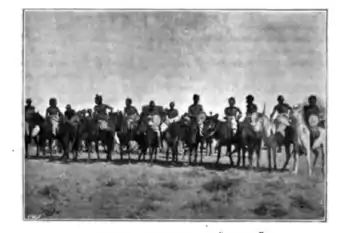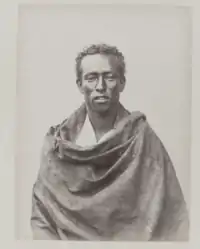Habr Je'lo
The Habr Je’lo (Somali: Habar Jeclo, Arabic: هبر جعلو, Full Name: Muuse Sheikh Ishaaq ibn Ahmad) is a major sub-clan of the wider Isaaq clan. The Habr Je'lo played a prominent role in the livestock and frankincense trade during the pre-colonial period. The Habr Je'lo also partook in a major organised front to oppose British rule in the late 19th and early 20th centuries under the leadership of Haji Sudi and other subsequent anti-colonial leaders hailing from the same clan. The Habr Je'lo are divided into three further sub-clans: the Mohamed Abokor, Musa Abokor, and Omar. Historically, the Mohammed Abokor were chiefly nomadic pastoralists, whereas the Musa Abokor and Omar obtained much of their wealth via their frankincense plantations in the mountainous interior adjacent to the coastline.[1]
Habr Je'lo هبر جعلو | |
|---|---|
| Regions with significant populations | |
| Languages | |
| Somali, Arabic | |
| Religion | |
| Islam (Sunni) | |
| Related ethnic groups | |
| Ayub, Habr Awal, Arap, Garhajis, and other Isaaq groups |
Distribution

The Habr Je’lo reside in eastern Togdheer, eastern Sahil, western Sanaag and western Sool regions in Somaliland. This sub-clan also inhabits the Somali region in Ethiopia, especially in the Degehbur zone.[2][3][4] They also have a large settlement in Kenya where they are known as a constituent segment of the Isahakia community.[5][6]

History
Pre-colonial era
The Habr Je’lo coastal settlements and ports, stretching from near Siyara in the west to Heis (Xiis) in the east, were important to trade and communication with the Somali interior. While the settlements were not as significant as the more established ports of Berbera, Zeila and Bulhar (respectively), the principle Habr Je’lo port of Kurrum (Karin) was a major market for livestock and frankincense procured from the interior,[7] and was a favorite for livestock traders due to the close proximity of the port to Aden. Habr Je’lo traders acted as middlemen to Dhulbahante livestock herders in the interior by purchasing and/or bartering their stock for export to the Aden market:
The last branch of the Western tribes is the Haber el Jahleh, who possess the sea-ports from Seyareh to the ruined village of Rukudah, and as far as the town of Heis. Of these towns, Kurrum is the most important, from its possessing a tolerable harbour, and from its being the nearest point from Aden, the course to which place is N.N.W., consequently the wind is fair, and the boats laden with sheep for the Aden market pass but one night at sea, whilst those from Berbera are generally three. What greatly enhances the value of Kurrum however is its proximity to the country of the Dulbahanta, who approach within four days of Kurrum, and who therefore naturally have their chief trade through that port.[8]
Anti-Colonial Movements

The Habr Je’lo were one of the first clans in the Somaliland Protectrate to revolt against the Colonial government between the late 19th and early 20th centuries. Among their prominent anti-colonial ideologues during the Dervish period were Deria Arale, Deria Gure, Abdallah Shihiri, Ibrahim Boghol and Haji Sudi, the latter is credited for importing Dervish customs into the Somali peninsula as well as being one of the original founders of the Somali Dervish Movement. Moreover, the Habr Je'lo played an influential role after the demise of the Dervish Movement in 1920, with Sheikh Bashir Yussuf and Farah Omar being important anti-colonial notables.

The Dervish movement first arose in Burao in 1899, where in the summer of that year Dervish leaders and their clan followers congregated at the settlement. Haji Suudi leading his clansmen declared war on the British lest they stop interfering with their religious and internal affairs. The dervish then proceeded to send this letter to Captain Cordeauxe and James Hayes Sadler:
This is to inform you that you have done whatever you have desired, and oppressed our well-known religion without any cause. Further, to inform you that whatever people bring to you they are liars and slanderers. Further, to inform you that Mahomed, your Akil, came to ask from us the arms we therefore, send you this letter. Now choose for yourself; if you want war we accept it, if you want peace pay the fine. September 1, 1899.[9]
According to the British War Office, the Ahmed Farah, Rer Yusuf and Adan Madoba Habr Je'lo sub-clans were among the first to join the Dervish rebellion. Haji Sudi, along with Mohammed Abdullah Hassan and Sultan Nur led the first Dervish forces against the British at Samala, Ferdidin, Erigo and Gumburu.[10][11] Moreover, The coastal Habr Je'lo sub-clans provided significant armaments to the Dervish forces in the interior.[12] Before sending troops to confront the Dervish at Samala, Consul-General Hayes Sadler gave the following instructions to the commander Eric John Eagles Swayne:
In the unlikely event of the Mullah offering to surrender, in his case and that of the Following: Haji Sudi, Deria Arale, Deria Gure Only an unconditional surrender should be accepted no guarantee of any kind to future treatment been given. Sultan Nur, the Sultan of the Habr Yunis, may be guaranteed his life. J. Hayes-Sadler, His Britannic Majesty's Consul-General, Somali Coast Protectorate. Aden April 11, 1901.[13]
Although facing the British in multiple battles between 1901 and 1904, the colonial forces failed to in their efforts to apprehend Sudi, Arale, Gure and their fellow Dervishes. Gabriel Ferrand, the Vice-Consul of France following these events observed that:
Neither the Mahdi nor his chief adviser Ahmed Warsama, better known under the name Haji Sudi, nor the Sultan Nur, leader of the Habr Younis clan were killed or captured. The optimism of Colonel Sadler and Lieutenant-Colonel Swayne in the latest reports relating to military operations is inexplicable.[14]
Abdalah Shihiri and Deria Arale led the 1904 Dervish delegation that facilitated the Ilig or Pestollaza agreement between the Dervish and Italy. This treaty allowed the Dervishes to peacefully settle in Italian Somaliland with some autonomy.[15][16]
In 1920, the British air force commenced their bombardment of Dervish fort and their ground assault on Taleh fort. Haji Sudi, the highest ranking Dervish after Mohammed Abdullah Hassan and Ibrahim Boghol, commander of the northern Dervish army died valiantly defending the Taleh.[17]
Clan Tree
- Sheikh Ishaaq Bin Ahmed (Sheikh Ishaaq)
- Habr Habuusheed
- Ahmed (Tol-Je'lo)
- Ibrahim (Sanbur)
- Mohamed (Ibran)
- Muuse (Habr Je'lo)
- Abokor
- Samane
- Jibril
- Omar
- Mohamed
- Adan Madoba
- Yesif
- Nuh
- Abdalla
- Abdille
- Abokor (Solomadow)
- Hasssan (Solomadow
- Barre (Solomadow)
- Hussein
- Allamagan
- Farah
- Beila
- Fahiye
- Dahir (Rer Dahir)
- Ahmed Farah
- Abdille
- Abdalla
- Musa Abokor
- Uduruhmin
- Idris
- Abdirahman
- Isman (Bah Majeelo)
- Abdille (Bah Majeelo)
- Isaaq (Bah majeelo)
- Yunis (Rer Yunis)
- Mohamed
- Isman
- Barre Abdirahman
- Ali Barre
- Mohamed
- Yunis
- Burale
- Baciido
- Abokor
Notable figures
- Ismail Ali Abokar – was a Major General and a senior member of the Supreme Revolutionary Council who also served as Vice President of Somalia from 1971 to 1982.
- Sheekh Bashiir – religious leader and post-dervish anti-colonial figure
- Ibrahim Boghol – member of the Dervish council and commander of the northern Dervish army
- Abdirashid Duale – a British-Somali entrepreneur and the CEO of Dahabshiil, an international funds transfer company.
- Kite Fiqi – military leader and poet
- Salaan Carrabey – legendary poet
- Musa Haji Ismail Galal – Somali linguist and historian who reformed the Somali Wadaad script and immensely contributed to the creation of the Somali Latin script
- Hadraawi – most notable contemporary Somali poet
- Michael Mariano – Veteran Somali politician, lawyer and businessman
- Ahmed Mohamed Mohamoud – former president of Somaliland
- Farah Omar – anti-colonial ideologue and founder of the first Somali Association
- Haji Sudi – chief lieutenant and one of the leaders of the Somali Dervish rebellion.
- Jama Haji Ahmed – governor of Maroodi Jeex region
- Mohamed Yusuf Abdirahman – mayor of Burao
- Suleiman Mohamoud Adan – speaker of the House of Elders of Somaliland
- Mohamoud Hashi Abdi – former Minister of Civil Aviation and Air Transport and Minister of Presidency of Somaliland
References
- Lewis, I. M. (3 February 2017). I.M Lewis: Peoples of the Horn of Afrcia. ISBN 9781315308173. |
- Anatomy of Violence: Understanding the Systems of Conflict and Violence in Africa. p. 130.
- "Changing Pastoralism in the Ethiopian Somali National Regional State (Region 5)".
- The Journal of the Royal Geographical Society, Volume 19, p. 63, 1848
- Waal, Alexander De (1993). "Violent deeds live on: landmines in Somalia and Somaliland, p. 63". |
- Lewis, I. M. (3 February 2017). I.M Lewis : peoples of the Horn of Afrcia. ISBN 9781315308173. |
- Ethnographie Nordost-Afrikas: Die Materielle Cultur Der Danakil, Galla Und Somal, 1893
- The Journal of the Royal Geographical Society, Volume 19, p. 63, 1848
- Sessional papers Volume 48. p. 15
- Official History of the Operation, Volume 1. p. 49
- In pursuit of The Mad Mullah, Malcolm McNeil. p. 123
- Official History of the Operation, Volume 1. p. 41
- Official History of the Operations in Somaliland. 1901–1904 Vol. I p. 54
- Les Çomâlis. Ferrand Gabriel, 1903. p. 268.
- Ministero della Guerra, Comando del Corpo di S.M./Ufficio Storico: SOMALIA, Vol. I, Dalle Original 1914, Roma, 1938- XVI, pp. 308, 309, 315, 318, 319.
- Caroselli, op. cit. 78-9.
- Sun, Sand and Somals - Leaves from the Note-Book of a District Commissioner, H. Rayne